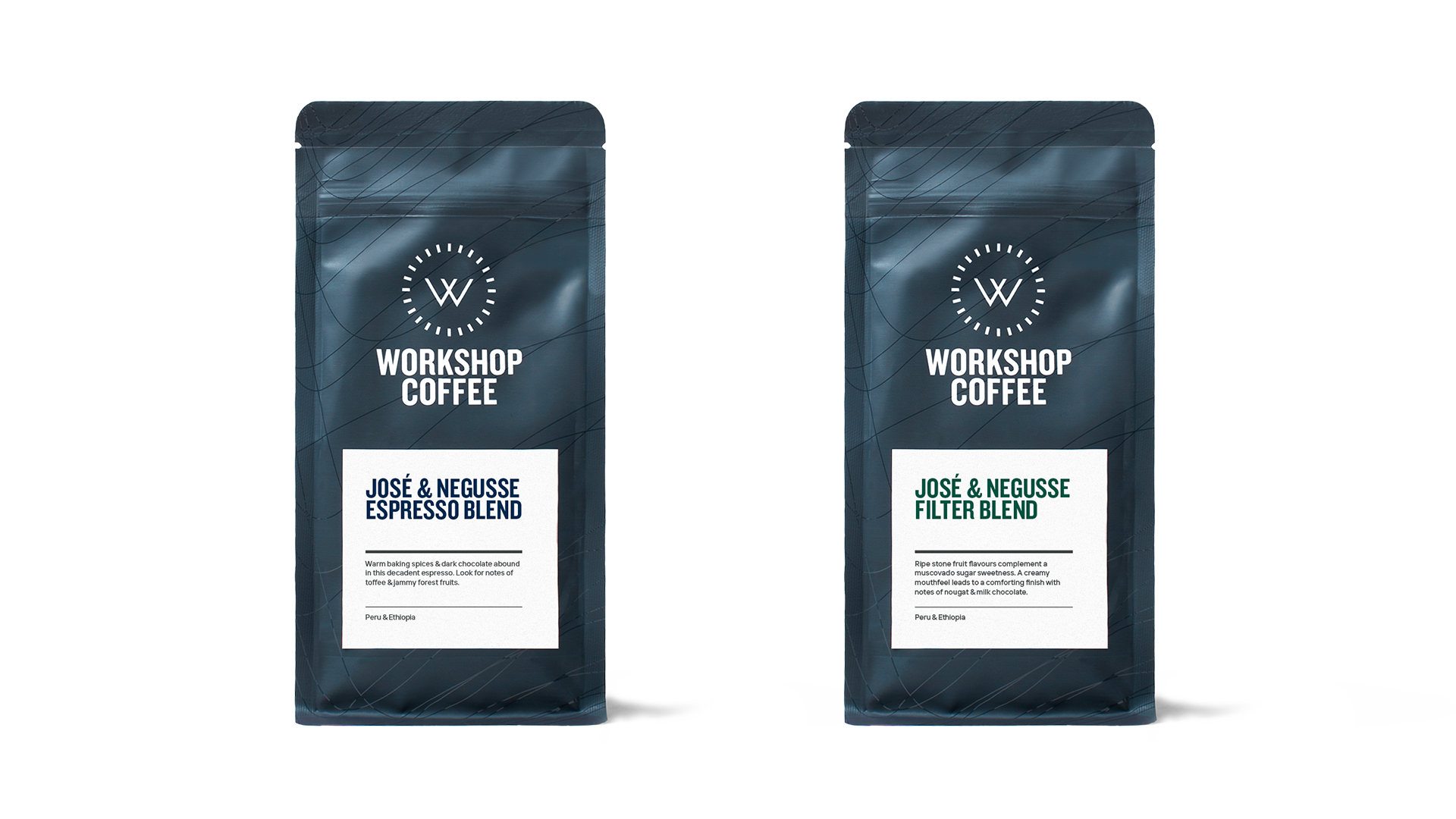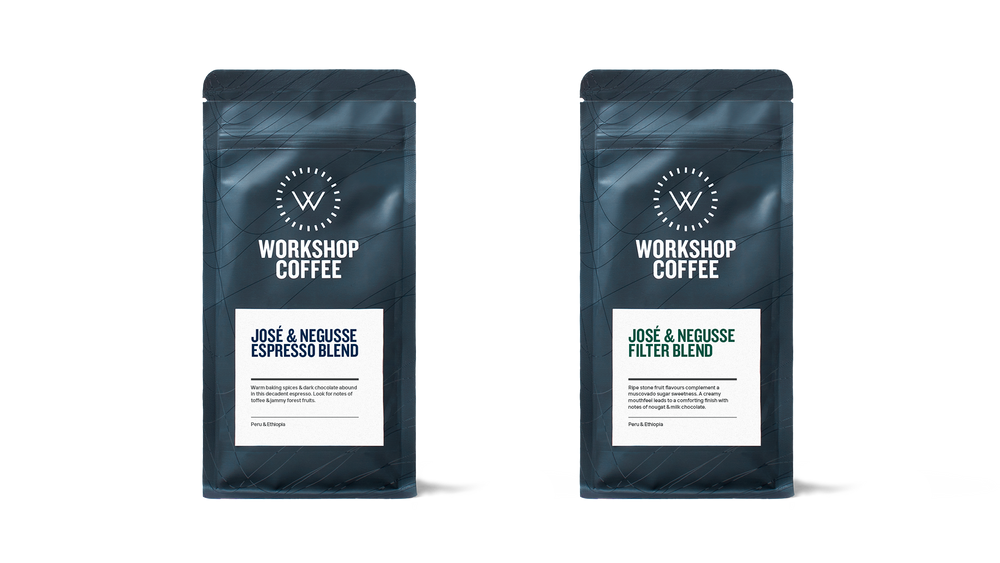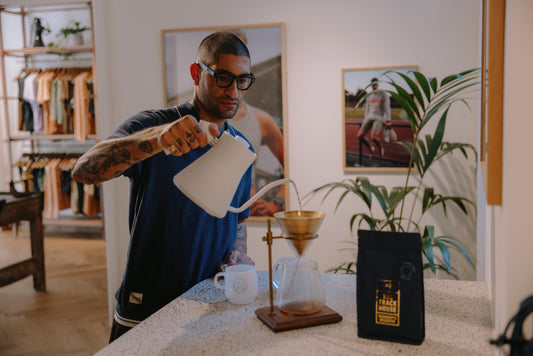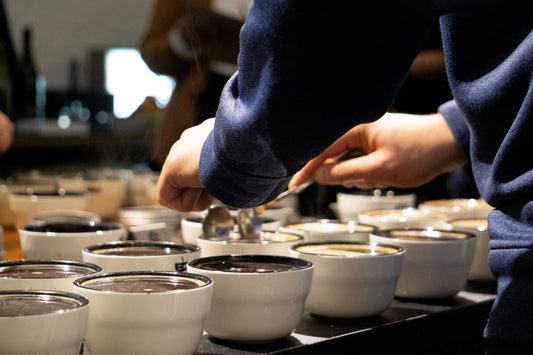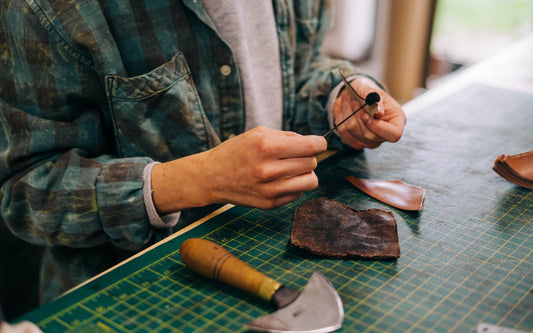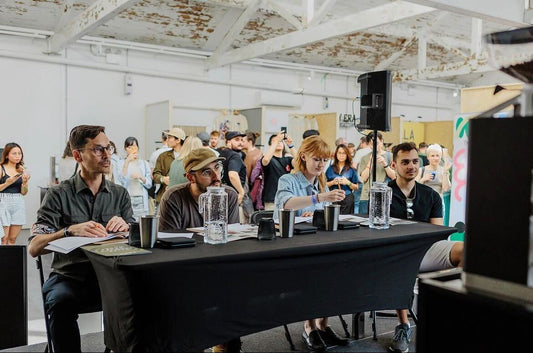
Some of our long standing customers will remember the days when our house espresso, named ‘Cult of Done’ after Bre Pettis’ manifesto, consisted of multiple coffees. In our early years it was a staple of our coffee offering, with an ever-rotating and seasonal mix of components offering fantastic quality results in terms of extraction and flavour.
However, I can distinctly remember a particularly palate-fatiguing quality control session when armed with two test roasts of an Ethiopian coffee called Aricha and a single plot coffee from Finca San Francisco in El Salvador. We trialled various ratios, altering the prominence of each test, testing out every combination from the four tests, before dejectedly reaching the conclusion that these two coffees simply didn’t blend well. We inevitably found the results to be jarring, sour, incomplete and less than the sum of their parts. This led to the realisation that purchase planning and forecasting are totally distinct practices from the nuances of creating a blend that works, synergistically.
It was always hard to get behind a blend, philosophically speaking. All we were doing was putting two or three delicious coffees together, hoping for compatibility in the ways they interacted, which could normally be wrangled via a tweak in our roasting approach, but this often involved some form of compromise. I felt a cognitive dissonance offering a blend whilst at the same time championing the producers of the coffees we were roasting and showcasing. Provenance and traceability were never sidelined, but it felt as though they were diluted when they didn’t get top billing.
Jump ahead and we have now been roasting for the best part of 12 years, and I am excited to introduce our newest addition to our coffee lineup...which is a blend.
‘Seasonal’, but not as you know it
A quick tangent, if you’ll permit me.
At the 2016 Aeropress Championships in England, Junya Yamasaki of Koya fame was one of the guest judges. Having the utmost respect for his palate and approach at his restaurants we thought it would be fun to stir the pot and include a non-coffee judge. After the competition, Junya invited some of us to the chef’s table at Koya for a private dining experience, where I had one of the most memorable mouthfuls of my lifetime.
Junya was more like a poet than a chef, curating and presenting, pulling out a wild stump of horseradish that he’d found on the side of the road, describing the root as ‘really grotesque, but kind of beautiful’, before grating it over our plates. One dish was meant to represent the transition of the seasons, with a small circle stamped out of a slice of pickled turnip adorned with a single, fresh plum blossom.
‘Eat it like a taco’ was our instruction. It was surprisingly tasty, but more than that it felt poignant and thought provoking. We were tasting the remnants of the Autumn, preserved over winter, livened up with a sprinkling of fresh spring time. ‘Seasonal’, yet not as you would normally know it.

'Cupping' coffee is a standardised industry-wide protocol to sensorily assess a sample of coffee. It can be focussed on analysing the quality of green coffee during a 'sample cupping' or as a means of assessing the roast quality of various batches during a 'production cupping'.
Freshness on paper versus freshness in the cup
We’ve never drifted from our core principles of buying clean and sweet coffees, roasting them carefully and in a considered manner, so that they’re always tasting fresh and vibrant. As such, we are a ‘seasonal’ roaster, and we are not alone here. Most roasters will offer coffee from similar origins throughout the year, and this is often driven by keeping stocks light and lean, accurate projections, and knowing full well that certain coffees just don’t stand up over time and need to be burnt through swiftly.
I recall cupping a whole table of offerings from Tim Wendelboe in late 2020, and I had to message him swiftly afterwards to ask what wizardry Jobneel was undertaking at Nacimiento. The coffee was harvested May 2019, and it tasted fresh as a daisy, sparkling, layered, juicy, with not a hint of fade. His reply was both informative and at the same time almost self-evident: the coffee lasts well because of good processing, drying, storage and packing.
We have had similar experiences with certain coffees we buy initially tasting very muted and uninteresting. It took the first few months before they would relax and slowly bloom and open up, becoming expressive and aromatic for an extended period before gracefully tapping out by turning down the volume on intensity, rather than tasting woody or vegetal.
It seemed as though the name of the game had changed, and offering ‘fresh on paper’ coffees wasn’t the only way to offer ‘fresh in the cup’ coffees. Was it possible to square the fact that coffees peak at different times with being staunch seasonalists? We began to adjust my mentality, moving away from wanting to be the ‘first’ or the ‘freshest’, which can miss the point and even warp potential purchasing in a negative way. The point is that our coffees taste great.

Parchment coffee resting in a cool warehouse in Calca. Samples will be pulled and manually milled and sorted to assess before lots are graded, collated and provisionally sold to the end customer. The coffee is then moved to a dry mill on the outskirts of Lima for processing and bagging up to ready the lots for export.
Fostering relationship coffees
Flavour aside, a large part of our buying approach is to understand in great detail where our coffees come from, and be as invested and committed in the process as possible. This year we will be roasting coffee from Gitesi for the 10th time, and it is our 8th time roasting Hunkute and Mahembe, which are examples of some of our more established relationships. Other farmers and groups we have been buying from for many years are very important to us, as well as to our customers for whom seeing familiar names on our offer list each year is reassuring and exciting.
We have been actively trying to mature ourselves as coffee buyers, and part of this process has been to move away from simply tasting everything we can ‘blind’ and pursuing the ‘tastiest’ lots. We now look to secure samples from producers and associations, as well as importers and exporters with whom we have a history, two-directional trust and an open, honest dialogue.
A new coffee demographic, or How I Learnt to Stop Worrying About Acidity and Love Balance
We are not the lightest roaster on the planet, but in the scheme of all coffee available in the marketplace we are definitely in the light-roast camp. Our filter roasts are typically very light, and even our espresso roasts would most likely be described as light to medium. There are, however, certain coffees that we want to buy that fare better when pushed a little further, allowing us to untap a new demographic. We have spent several years developing a range of coffees from producers:
- with whom we can see potential to improve quality if they are able to reinvest in their farms.
- from whom we’ve bought previously but maybe the quality didn’t quite stack up one year.
- from whom we want to buy more coffee but don’t have space in our mainline range for their entire production.
The analogy I have heard before which is used to describe a good green buyer is that we don’t want to simply ‘pick the raisins out of the cake’. Taking only the top lots leaves the bulk of coffee behind, which is the producer’s bread and butter. Well produced and clean lots like these can quite often be delicious as well as more suitable for certain markets, when compared to lots with cup profiles that particularly excite us and those initiated in the specialty coffee industry.
Our buying has never been directed by cup score, but by flavour profile and potential to retain character over time. Roasting for hotels and restaurants has sharpened our skills not just as buyers but also as roasters, learning how to modulate acidity, develop coffees differently for ease of use and for a different range of beverages ultimately being prepared and served. We're proud that introducing such coffees to these sorts of customers has enabled us to strengthen our buying ethics and build more volume with the groups and producers we love.

Some of the tubs used during the hand sorting of drying parchment on raised beds at Snap-owned Worka Chelbesa washing station, in Ethiopia's Gedeo zone.
Developing a constant
Typically, coffees in Ethiopia are harvested between November and January, whilst Peruvian coffees are picked between June and August. Containers from Ethiopia arrive in spring, and from Peru in winter, making for two nicely timed drops throughout the year. If we get our ducks in a row we are able to sub in a fresh component twice during the calendar year and offer a blend of these two origins, more specifically from the two producer groups with whom we’ve worked for several years and had fantastic, ever-improving results.
By topping and tailing Ethiopian and Peruvian coffees in this fashion we have begun to understand the interplay between the two, how best to achieve optimal development on each to achieve balance in the cup and uniform behaviour. It wasn’t sudden, and has taken a fair amount of experimenting, but we have reached the point where we can say, hand on heart, “if you order this coffee any day of the year it will taste great”.

Agustin Ccasa Ccoyo at Finca Progreso in Huaynapata, Cusco, grappling with a particularly willowy Bourbon coffee tree.
Valle Inca Association & José Prudencio
The first year we bought coffee from the Valle Inca Association was in 2018, thanks to an introduction via Promoting Peru. We ended up roasting two lots, one from Ricardo Ccallo Olave at Pampa Blanca in Quinuay and another from Agustin Ccasa Ccoyo at Finca Progreso in Huaynapata. These lots represented about 6.5% of our total purchasing that year.
The following year we bought yet more bags from the Valle Inca group, including new producers like Yolanda Cabrera Alvarez, Juan José Huillca Singuña, Rafael Tupayupanqui Vargas and Miranda Huaman Gregoria, which represented over 12% of our volumes for that year. Being able to visit some of these producers, as well as travel and cup with José Prudencio to see the warehousing and dry milling operations that Valle Inca use, was informative and helped us to calibrate and plan together for the following year.
This year we have finalised our purchasing quantities, which equate to an entire container from one origin. Our relationship with Valle Inca has steadily grown, and so to have their operations, expanding from 100 members in 2018 to more than 261 producers around the Cusco region by the beginning of 2021. All the members are working organically and are certified as such via the Valle Inca group. For a member to join, there needs to be a baseline of quality met, dictated in part by altitude and the type of varieties planted, but ultimately it is down to the desire of each member to improve their quality through hard work.
As well as paying premium prices Valle Inca support their producers in many ways. They offer pre-financing, aid in the building and purchasing of drying infrastructures and processing materials, offer agronomical advice and harvest planning and protocols. Several of their members, including Agustin, reliably place well in Peru’s Cup of Excellence competition.

Squeaky clean parchment coffee drying on the raised beds at Snap's Raro Boda washing station in Uraga, located within Ethiopia's Guji Zone.
Snap Coffees & Negusse Debela Weldyes
Snap Coffees in Ethiopia first came to our attention via Nordic Approach. We’ve purchased lots from several of their washing stations over the last three years. The likes of Refisa, Riripa, Worka Chelbesa, Danche and Raro Boda are washing stations owned and operated by Snap Coffees, and we have always had them at the top of our priority list when working with Nordic Approach and other importers to secure sample materials and make our buying selections.
Established in 2008 by Negusse Debela Weldyes, the group are responsible for the running and operation of several coffee washing stations. Abenezer Asfaw oversees logistics and supply chain mapping, and is the liaison for Tropiq, which is Nordic Approach’s sister company with a team on the ground in Ethiopia year-round. Abenezer and his team oversee the processing facilities but also take on the task of dispensing agricultural knowledge to their contributing farmers. They are committed to recycling waste by-products from coffee processing at each of their stations where they have also built schools and provided them with computing equipment from the other arm of their business which is in electronics. They intend to improve the roads to streamline access to the washing stations as well as build health clinics to provide access to better healthcare for their contributing farmers as well.
Lots from the most recent harvests have been dry milled at Snap’s new processing and warehousing facility, which has just been fitted out. This has afforded the group even more control over the final exportable product that we get to work with, leading to improved consistency and uniformity. They receive premium payments because of the high qualities being produced.
The strong starting block of well-nourished, high-quality variety coffee trees, coupled with their attention to detail in processing, through renewing and tiling fermentation tanks and slow, cool temperatures during fermentation and drying, means that these beautiful washed, organic lots from Ethiopia always deliver a wealth of complexity for an extended period, and we have come to be reliant on them as a backbone of our buying approach.
 Our trusty P25 Probat in action, which has been our sole roasting machine for the last 7 years.
Our trusty P25 Probat in action, which has been our sole roasting machine for the last 7 years.
José & Negusse
It will always feature a component from a Valle Inca Association producer and a component from one of Snap Coffees’ washing stations. Rather than obscure or dilute traceability and provenance we are still hoping to champion the producer groups upon whom this coffee relies via naming their respective presidents, José Prudencio and Negusse Debela Weldyes.
We hope that in offering this blend we will enable ourselves to strengthen our ties with these two producer groups, building more volumes with them, as well as offering some stability and constancy in our coffee range.
Share:


